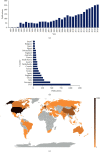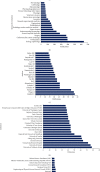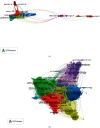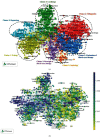Global Research Trends in Shock Wave for Therapy from 1990 to 2019: A Bibliometric and Visualized Study
- PMID: 33506013
- PMCID: PMC7810560
- DOI: 10.1155/2021/3802319
Global Research Trends in Shock Wave for Therapy from 1990 to 2019: A Bibliometric and Visualized Study
Abstract
Objective: The publications of application and development of shock wave therapy showed consistent growth. The aim of this study was to investigate the global status and trends in the shock wave therapy field.
Methods: Publications about shock wave therapy from 1990 to 2019 were collected from the Web of Science database. The data were studied and indexed by using bibliometric methodology. For a visualized study, VOSviewer software was used to conduct bibliographic coupling analysis, coauthorship analysis, cocitation analysis, and co-occurrence analysis and to analyze the publication trends in shock wave therapy.
Results: A total of 3,274 articles were included. The number of publications was increasing per year globally. The USA made the largest contributions to the global research with the most citations (the highest h-index). The Journal of Urology had the highest publication number. The University of California System was the most contributive institution. Studies could be divided into seven clusters: urology, hepatology, cardiology, orthopedics, mechanism research of shock wave therapy, andrology, and principle of shock wave therapy. Orthopedics, andrology, and mechanism research of shock wave therapy could be the next hot topics in this field.
Conclusions: Base on the trends, shock wave therapy is the theme of a globally active research field which keeps developing and extends from bench to bedside.
Copyright © 2021 Qingxi Zhang et al.
Conflict of interest statement
The authors declare that there is no conflict of interest regarding the publication of this paper.
Figures








Similar articles
-
The global state of research in nonsurgical treatment of knee osteoarthritis: a bibliometric and visualized study.BMC Musculoskelet Disord. 2019 Sep 4;20(1):407. doi: 10.1186/s12891-019-2804-9. BMC Musculoskelet Disord. 2019. PMID: 31484517 Free PMC article.
-
Global research trends in stem cells for osteoarthritis: a bibliometric and visualized study.Int J Rheum Dis. 2018 Jul;21(7):1372-1384. doi: 10.1111/1756-185X.13327. Int J Rheum Dis. 2018. PMID: 29968331
-
The State of Exosomes Research: A Global Visualized Analysis.Biomed Res Int. 2019 Apr 3;2019:1495130. doi: 10.1155/2019/1495130. eCollection 2019. Biomed Res Int. 2019. PMID: 31073519 Free PMC article.
-
Bibliometric analysis of global research on PD-1 and PD-L1 in the field of cancer.Int Immunopharmacol. 2019 Jul;72:374-384. doi: 10.1016/j.intimp.2019.03.045. Epub 2019 Apr 24. Int Immunopharmacol. 2019. PMID: 31030093 Review.
-
Global scientific trends on the immunomodulation of mesenchymal stem cells in the 21st century: A bibliometric and visualized analysis.Front Immunol. 2022 Aug 24;13:984984. doi: 10.3389/fimmu.2022.984984. eCollection 2022. Front Immunol. 2022. PMID: 36090982 Free PMC article. Review.
Cited by
-
Global trends in research on extracorporeal shock wave therapy (ESWT) from 2000 to 2021.BMC Musculoskelet Disord. 2023 Apr 20;24(1):312. doi: 10.1186/s12891-023-06407-9. BMC Musculoskelet Disord. 2023. PMID: 37081473 Free PMC article.
-
Global Research Trends in Tendon Stem Cells from 1991 to 2020: A Bibliometric and Visualized Study.Stem Cells Int. 2022 Jun 18;2022:7937765. doi: 10.1155/2022/7937765. eCollection 2022. Stem Cells Int. 2022. PMID: 35765660 Free PMC article.
References
-
- Ogden J. A., Alvarez R. G., Levitt R., Marie Marlow R. N. Shock wave therapy in musculoskeletal disorders. Clinical Orthopaedics and Related Research. 2001;387:22–40. - PubMed
-
- Valchanow V., Michailow P. High energy shock waves in the treatment of delayed and non-union fractures. International Orthopaedics. 1991;15:181–185. - PubMed
MeSH terms
LinkOut - more resources
Full Text Sources
Other Literature Sources

